
Tephrocactus geometricus Photo by: Flavio Agrosi
Origin and Habitat: Argentina Catamarca ( Angostura de Guanchim and Tinogasta ) and Bolivia border.
Altitude: (1300?)2200-2900 metres above sea level.
Habitat It grows fully exposed to blazing hot sun in an extremely arid habitat, between red violet coloured rocks and gravel in flat or moderately step and very drained clayey and sandy soils. It it is often found growing along with a very sparse vegetation of Puna bonnieaeSN|1023]]SN|1023]], Lobivia famatimensisSN|3315]]SN|3315]] v. bonnieae, Echinopsis leucanthaSN|8246]]SN|8246]], Pterocactus tuberosusSN|1126]]SN|1126]], Cumulopuntia sp., Maihueniopsis sp. and Opuntia sulphurea.
Synonyms:
See all synonyms of Tephrocactus geometricus
back
Accepted name in llifle Database:Tephrocactus geometricus (A.Cast.) Backeb.Möller's deutsche gärtner-zeitung 1934, xlix. 105, in obs., nomen; et Backeb. in Backeb. & F.M.Knuth Kaktus-ABC [Backeb. & Knuth] 111. 1936 [12 Feb 1936]Synonymy: 4
back
Description: Tephrocactus geometricusSN|22328]]SN|14349]] is an extraordinary species that shows a strong adaptation to extreme desert habitat, with dwarf growth and geophytic habit. It is one of the showiest “opuntia” species sought-after by cacti impassioned, a strange "geometric" plants but fabulous flowers.
Habit: Small low-growing globular segmented cactus loosely branched into small clumps.
Stem segments: 4-5 cm in diameter, clear glaucous/blue that reddens to purple in full sun exposure. New growing cladodes are dark purple.
Leaves: Very reduced, ephemeral.
Areoles: A caducuous white felt is present in young areoles.
Glochids: Not present, or very reduced.
Spines: Spineless, or with some spines sporadically present in the upper areoles, 2-15 mm long, white to black, very thin or somewhat robust, flattened, appressed and turned downward.
Flower: White to light pink with a darker midstrip. Flowers last only one day.
Related species: T. geometricus is closely related with Tephrocactus alexanderiSN|22328]]SN|22328]] and sometime considered a synonym of the latter. Tephrocactus alexanderiSN|14349]]SN|22328]] occurs in the mountains in a disjunct population and has different characteristics.
Subspecies, varieties, forms and cultivars of plants belonging to the Tephrocactus geometricus group
 Tephrocactus geometricus (A.Cast.) Backeb.: Small globular segmented cactus that cluster into small clumps.The “Geometric” segments are 4-5 cm in diameter, clear glaucous/blue that reddens to purple in full sun exposure. New growing cladodes are dark purple.
Tephrocactus geometricus (A.Cast.) Backeb.: Small globular segmented cactus that cluster into small clumps.The “Geometric” segments are 4-5 cm in diameter, clear glaucous/blue that reddens to purple in full sun exposure. New growing cladodes are dark purple. Tephrocactus geometricus f. inermis hort.: Spineless, or with very few solitary thin spines sporadically present in the upper areoles.
Tephrocactus geometricus f. inermis hort.: Spineless, or with very few solitary thin spines sporadically present in the upper areoles.
Notes: Tephrocactus geometricusSN|14349]]SN|14349]] is an example of hexagonal configurations of stem-segments surface, other plant that show hexagonal tubercles comprises Matucana krahniiSN|6031]]SN|6031]] and Thelocactus hexaedrophorusSN|10830]]SN|10830]].
Bibliography: Major references and further lectures
1) Curt Backeberg “Die Cactaceae: Handbuch der Kakteenkunde” Volume 1G. Fischer, 1958
2) Stuart Max Walters “The European garden flora. 3.[Angiospermae], Dicotyledons. [Casuarinaceae to Aristolochiaceae]” Cambridge University Press, 1989
3) Edward Anderson “The Cactus family” Timber Press, Incorporated, 2001
4) W. Stuppy “A new combination in Tephrocactus Lem. (Cactaceae)” Kew Bulletin 56:1003-1005 2001
5) James Cullen, Sabina G. Knees, H. Suzanne Cubey "The European Garden Flora Flowering Plants: A Manual for the Identification of Plants Cultivated in Europe, Both Out-of-Doors and Under Glass" Cambridge University Press, 11/Aug/2011
6) David R Hunt; Nigel P Taylor; Graham Charles; International Cactaceae Systematics Group. "The New Cactus Lexicon" dh books, 2006
8) Clive Innes, Charles Glass “The Illustrated Encyclopedia of Cacti” Knickerbocker Press, 1997
9) Kiesling, R., Ortega-Baes, P. & Méndez, E. 2013. Tephrocactus alexanderi. The IUCN Red List of Threatened Species 2013: e.T151836A566851. http://dx.doi.org/10.2305/IUCN.UK.2013-1.RLTS.T151836A566851.en. Downloaded on 27 March 2016.
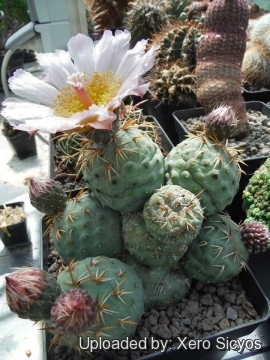 Tephrocactus geometricus Photo by: Xero Sicyos
Tephrocactus geometricus Photo by: Xero Sicyos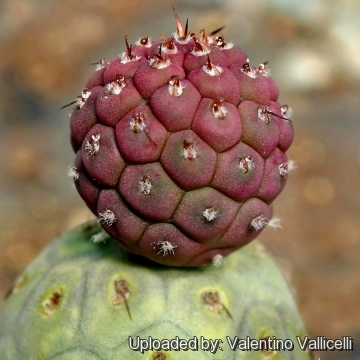 - Nectar drops on a new cladode. Photo by: Valentino Vallicelli
- Nectar drops on a new cladode. Photo by: Valentino Vallicelli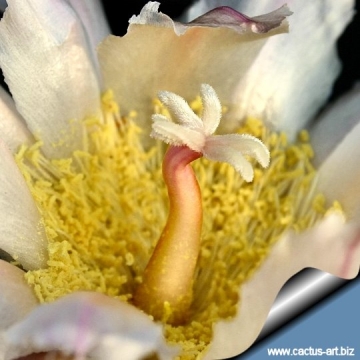 Tephrocactus geometricus Photo by: Cactus Art
Tephrocactus geometricus Photo by: Cactus Art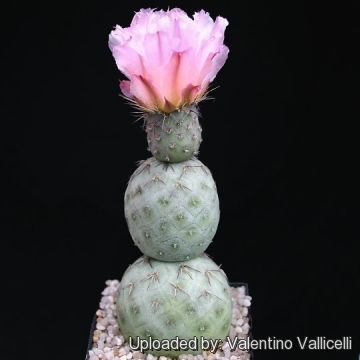 Tephrocactus geometricus Photo by: Valentino Vallicelli
Tephrocactus geometricus Photo by: Valentino Vallicelli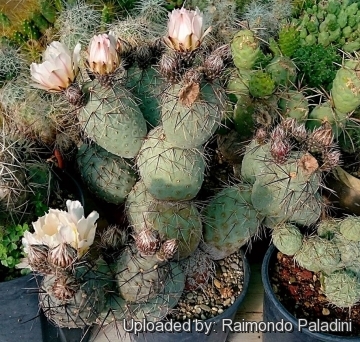 Tephrocactus alexanderi var. geometricus Rap177 - A45, 22 km west Fiambalà, Chascul, Catamarca, Argentina. Photo by: Raimondo Paladini
Tephrocactus alexanderi var. geometricus Rap177 - A45, 22 km west Fiambalà, Chascul, Catamarca, Argentina. Photo by: Raimondo Paladini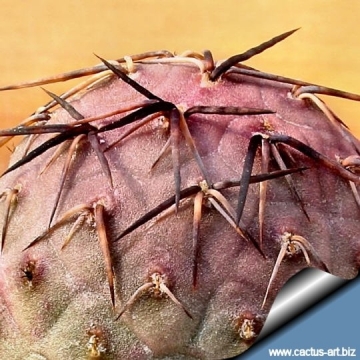 Tephrocactus geometricus Photo by: Cactus Art
Tephrocactus geometricus Photo by: Cactus Art Tephrocactus geometricus Photo by: Diego Armentano
Tephrocactus geometricus Photo by: Diego Armentano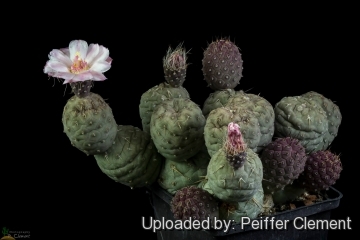 Tephrocactus geometricus Photo by: Peiffer Clement
Tephrocactus geometricus Photo by: Peiffer ClementCultivation and Propagation: It is susceptible to overwatering, but need enough water during the growing season. This mountain cactus - because of the elongated fat taproot - necessitate deep pots and a well drained mineral potting mix. It prefers a full sun exposure, but should be protected from excessive heat and sun in summer.
Growth rate: Slow growers, they produce only one, or a very few, new cladodes per year, but easy to flower.
Frost Tolerance: They tolerate light frost -5 (-10) °C.
Need to be kept in a cool place during winter rest this is important for the flowers as well as for their health. Without this cool winter period they normally wont get many buds. Keep dry in winter to avoid rot. Need a sufficient amount of air.
Propagation: Seeds are extremely difficult to germinate. Soak seeds overnight in water. Put them in damp paper towel next day. Put all that in ziplock. Keep at 35° C during 'daytime' and 16° C during 'night'. Wait for about a week and start checking for signs of germination (roots). Move germinated plants / seedlings to regular soil. Three weeks later dry non germinated seeds, leave them for a about a month and try again. Best reproduced from rooted cuttings. Grafting is often used to speed growth rate and to create a back-up for plants in collection.
Your Photos

by Flavio Agrosi
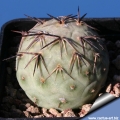
by Cactus Art

by Valentino Vallicelli

by Valentino Vallicelli

by Valentino Vallicelli
























